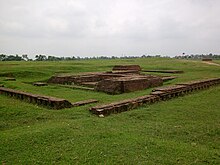KarnasuvarnaorKarnasubarna(Bengali:কর্ণসুবর্ণ অথবা কানাসুনা) was an ancient city, located in the present dayBerhamporeCD blockin theBerhampore subdivisionofMurshidabad district,West Bengal, India. It was the capital ofGauda Kingdom.[1]
Kānsonā | |
 Remains of Raktamrittika Vihara, c. 600 CE | |
| Alternative name | Karnasubarna |
|---|---|
| Location | West Bengal,India |
| Coordinates | 24°01′49″N88°11′27″E/ 24.03028°N 88.19083°E |
| Type | Settlement |
| History | |
| Founded | 7th century AD |
| Site notes | |
| Excavation dates | 1929–30, 1962 |
| Archaeologists |
|
| Ownership | Archaeological Survey of India, University of Calcutta |
Geography
edit5miles
River
River
River
River
M: municipal town, CT: census town, R: rural/ urban centre, H: historical centres
Owing to space constraints in the small map, the actual locations in a larger map may vary slightly
Area overview
editThe area shown in the map alongside, coveringBerhamporeandKandisubdivisions, is spread across both the natural physiographic regions of the district,Rarhand Bagri.[2][3]The headquarters of Murshidabad district,Berhampore,is in this area.[4]The ruins ofKarnasubarna,the capital ofShashanka,the first important king of ancientBengalwho ruled in the 7th century, is located 9.6 kilometres (6.0 mi) south-west of Berhampore.[5][6][7]The entire area is overwhelmingly rural with over 80% of the population living in the rural areas.[8]
Note: The map alongside presents some of the notable locations in the subdivisions. All places marked in the map are linked in the larger full screen map.
History
editKarnasuvarna (meaning 'made beautiful byKarna' or 'Gold of Ear', for 'karna' also means ear, and 'suvarna' means both beautiful and Gold, as evident from the Bangla name 'Kānsonā', where 'Kān' is ear and 'sonā' is Gold) was the capital ofGauda Kingdomduring the reign ofRaja Shashanka,the first important king of ancientBengalwho ruled in the 7th century. karnasuvarna was also known as KanaSona (কানাসুনা) by local people. According to folklore, it was the capital of Mahabharata kingKarna.After Shashanka's death it was theJayaskandhavara(camp of victory) ofBhaskaravarman,the king ofKamarupaprobably for a short period. This is evident from hisNidhanpur copper-plate grant.In the mid-7th century, it was the capital of Jayanaga according to his Vappa Ghoshavata copper-plate grant. The ruins of Karnasuvarna have been located at Kansona in the presentMurshidabad districtin theIndianstateofWest Bengal.[9][10]It is 9.6 kilometres (6.0 mi) south-west ofBerhampore,headquarters of Murshidabad district.[11]
In theList of Monuments of National Importance in West Bengalthe following are shown as ASI listed monuments:[12]
- Mounds known as Devil’s Mound and Raja Karna’s Palace at Rangamati (Item No. 118).
- Nil Kuthi Mound at Mouza Chowk, Chandpara (Item No. 128).
Excavations at Rajbaridanga
editThe famous Chinese travelerXuanzangmentioned in his travelogues aboutLo-to-mo-chi(Raktamrittika) Mahavihara, an important centre of learning ofVajrayanaBuddhists near Karnasuvarna. It has been identified with Rajbaridanga. The archaeological site of Rajbaridanga is about 2.4 km from Karnasuvarna railway station in the bank of theBhagirathi River.Local transport like cycle vans, e-rickshaws (Toto) are available. This site was first excavated by a team from the Department of Archaeology,University of Calcuttain 1962 under the direction of S.R. Das.[13]Amongst the findings, the most significant one was a monastic sealing bearing the legendShri Rakta(m)rttika (Ma)havaiharik arya bhikshu (samgha)s(y)a(of the community of venerable monks residing in the Shri Raktamrittika Mahavihara). The other significant findings are terracotta figurines and ornamental stucco mouldings including human heads. Two other sites close by have been excavated at Rakshashidanga (in 1929–30 by K.N. Dixit of the Archaeological Survey of India) and Nil Kuthi.[14]
Rakshasi Danga and Rajbari Danga
editMounds locally known as Rakshasi Danga (Demoness’ Ground) and Rajbari Danga (Raja’s Palace Ground) have been excavated by the Archaeological Survey of India and the Archaeological Department of the University of Calcutta. The discovery of terracotta seals “bearing the legendRaktamrittika Mahaviharahas identified the location of the monastery bearing the same name described in the accounts ofHiuen Tsang”,Chinese Buddhist monk and scholar who visited the place in the 7th century AD. The entire area contains “vestiges of ancient remains” from 2nd century AD to 15-16th century AD.[15]
Nilkuthi Mound
editNilkuthi Mound, adjacent to Rajbari Danga, is at a higher level, has yielded antiquities sporadically.[16]
Transport
editKarna Subarna railway station(earlier known as Chiruti) is on theBarharwa-Azimganj-Katwa loopofEastern Railway.
Bus services are available to district headquarters Baharampur from Karnasubarna.
Healthcare
editKarnasuvarna Block Primary Health Centre, with 15 beds, is a government medical facility in Berhampore CD block.[17]
Gallery
edit-
Well, Archaeological site of Karnasuvarna
-
Karnasuvarna, Rajbari Danga
-
Karnasuvarna ground
-
ASI Board at karnasuvarna
References
edit- ^Majumdar, R. C.(1971).History of Ancient Bengal.Calcutta: G. Bhardwaj & Co. pp. 6–8.OCLC961157849.
- ^"District Census Handbook: Murshidabad, Series 20 Part XII A"(PDF).Physiography, Page 13.Directorate of Census Operations, West Bengal, 2011.Retrieved24 July2017.
- ^"Murshidabad".Geography.Murshidabad district authorities.Retrieved24 July2017.
- ^"Murshidabad".Murshidabad district authorities.Retrieved12 September2017.
- ^Ray, Nihar Ranjan,Bangalir Itihas Adi Parba,(in Bengali),1980 edition, pp. 160-161, Paschim Banga Niraksharata Durikaran Samiti
- ^Sengupta, Nitish,History of the Bengali-speaking People,p.25, UBS Publishers’ Distributors Pvt. Ltd.
- ^Majumdar, Dr. R.C.,History of Ancient Bengal,first published 1971, reprint 2005, pp. 5-6, Tulshi Prakashani, Kolkata,ISBN81-89118-01-3.
- ^"District Census Handbook, Murshidabad, Series 20, Part XII B"(PDF).District Primary Census Abstract page 26.Directorate of Census Operations West Bengal.Retrieved2 July2021.
- ^Ray, Nihar Ranjan,Bangalir Itihas Adi Parba,(in Bengali), 1980 edition, pp. 160–161, Paschim Banga Niraksharata Durikaran Samiti
- ^Sengupta, Nitish,History of the Bengali-speaking People,p.25, UBS Publishers’ Distributors Pvt. Ltd.
- ^Majumdar, Dr. R.C.,History of Ancient Bengal,first published 1971, reprint 2005, pp. 5–6, Tulshi Prakashani, Kolkata,ISBN81-89118-01-3.
- ^"List of Ancient Monuments and Archaeological Sites and Remains of West Bengal - Archaeological Survey of India".Item no. 108.ASI.Retrieved16 July2021.
- ^Ghosh, A., ed. (1965)."Indian Archaeology 1962–63 – A Review"(PDF).Archaeological Survey of India. p. 46.Retrieved26 October2009.
- ^"Karnasuvarna".Rangan Datta, free-lance travel writer and photographer.Retrieved23 September2009.[permanent dead link]
- ^"Mounds known as the Devil's Mound and Raja Karna's Palace".ASI, Kolkata Circle.Retrieved3 June2018.
- ^"Nilkuthi Mound Mouza Chawk, Chandpara".ASI, Kolkata Circle.Retrieved3 June2018.
- ^"Health & Family Welfare Department".Health Statistics.Government of West Bengal.Retrieved19 September2017.
External links
edit- Media related toKarnasuvarnaat Wikimedia Commons
- Murshidabadtravel guide from Wikivoyage
